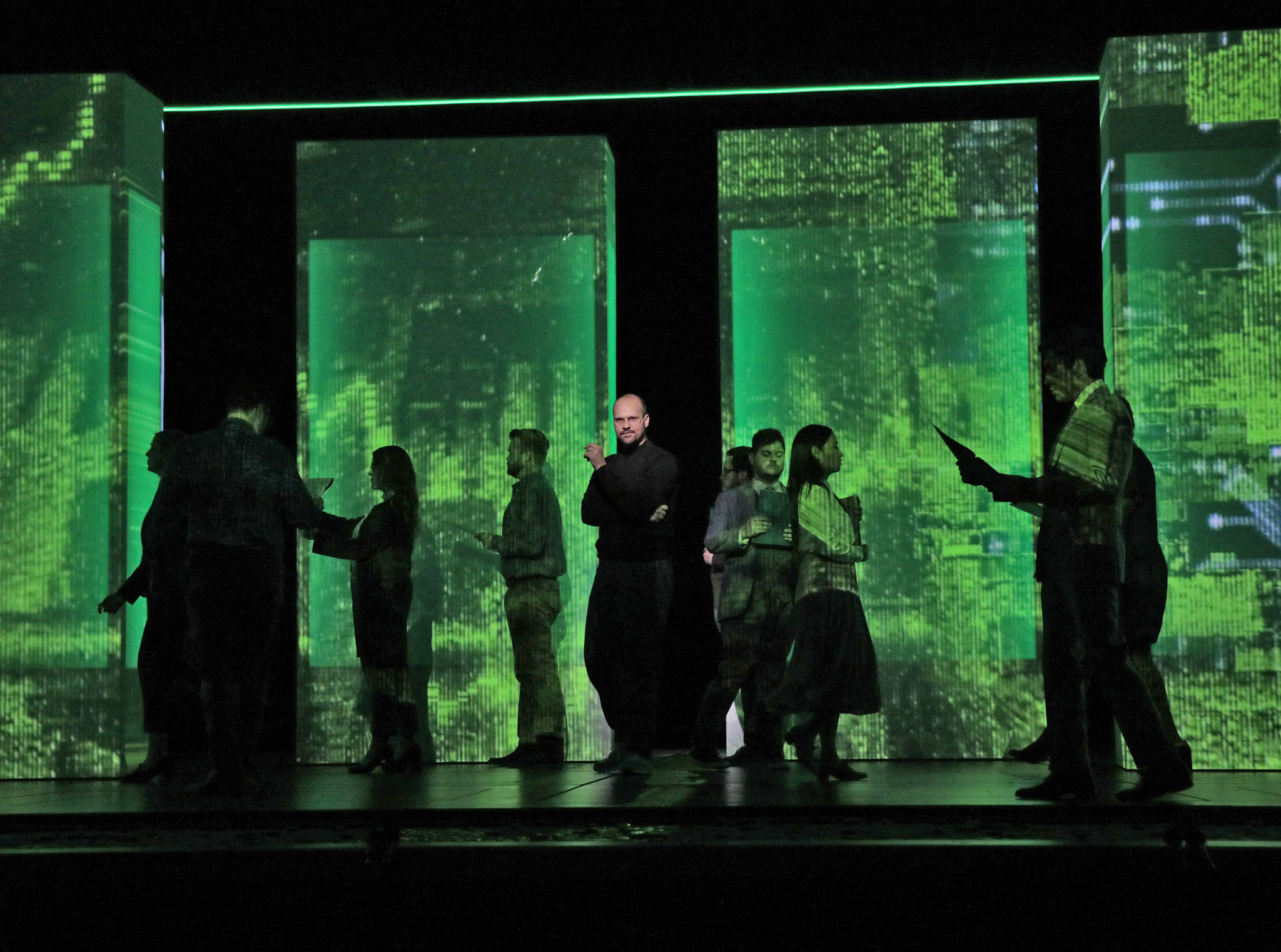For all its up-to-the-minuteness in sound and subject, the Grammy-winning opera The (R)evolution of Steve Jobs, which opened Saturday night at Seattle Opera, does, with amusing irony, observe one ancient operatic convention. Scene 1 depicts the 2007 launch of the iPhone, and the unabashed self-hagiography of Jobs’ introductory speech extolling its (his) virtues recalls, of all things, French baroque operas of 300 years ago, which traditionally opened with a choral scene in praise of their patron Louis XIV—a man, we are led to believe, of a somewhat smaller ego than Jobs’.
This is Jobs’ apex, from which Mark Campbell’s libretto jumps backward and forward in time to trace, in 17 scenes (plus a childhood flashback prologue and epilogue), his rise and decline. Or rises and declines, actually, in several overlapping areas: health, relationships, and career. Co-commissioned with opera companies in Santa Fe and, naturally, San Francisco, (R)evolution brings in Jobs’ wife Laurene (Emily Fons), his spiritual adviser Kobun (Adam Lau), Apple co-founder Steve Wozniak (Garrett Sorenson), and Chrisann (Madison Leonard), an early girlfriend and the mother of Jobs’ child. The role of Jobs himself, who is never offstage more than a few seconds, is a tour de force for John Moore.
Mason Bates’ score is unfailingly inventive and often gorgeous, adding electronic sound effects and synth timbres, an acoustic guitar, and a large percussion battery to a traditional orchestra. It’s all mixed with a masterly ear for color, and, though Bates isn’t 100 percent successful in keeping reminiscences of John Adams’ music out of it, he’s fearless in embracing extremes of beguiling prettiness and dramatic grit, of Zen quiescence and hurtling, go-go-go frenzy. Each of the five principals gets a solo spotlight, and for those who love powerful stand-and-deliver arias, Bates provides them, the voices riding Straussian swells of sound. (If the 90-minute opera had an intermission, Jobs’ Scene 9 showstopper would end Act 1 rousingly.) Visually, the production is both minimalist and beautiful: Vita Tzykun designed moving panels which combine and recombine (the anonymous movers got a deserved curtain call) and onto which images both representational and abstract are projected; the video design is credited to 59 Productions and Benjamin Pearcy. It’s by some distance Seattle Opera’s most extensive, effective, and eye-filling use of video.
So (R)evolution’s sonic and visual surface—what Jobs might call a user interface—is expertly and thrillingly presented. What’s underneath is problematic. How does Steve the idealistic “phreak” who name-checks Cesar Chavez and vows to “take down the corporate Goliaths” in Scene 5 and hallucinates Bach during an acid trip in Scene 6 become—with off-putting suddenness—Steve the asshole who demands Chrisann get an abortion in Scene 9 and refuses to pay her child support in Scene 12? Though Moore plays these mood swings vividly and convincingly, the opera makes no attempt to explain them. It does, though, draw a neat allegory between Jobs’ emotional inscrutability and the culture-changing technological and design features he pioneered—the facelessness of those beige boxes revealing nothing of their inner workings (“No clutter, no wires”) and Jobs’ icy promotion of the iPhone as a way to “to control all those messy moments in your life.” It’s clever, but it answers no questions.
But what the opera’s creators presumably didn’t anticipate was that this allegory ended up applying to their work as a whole. Sure, we happily use our computers and smartphones without knowing or caring about the innards, but that’s not what we want from art. Admittedly, Campbell and Bates took on a challenge: How do you make absorbing theater out of a man whose most salient trait was determined impenetrability; how do you make an audience care about a man who was unconcerned whether the people in his life cared? Successful in every other way, The (R)evolution of Steve Jobs falls a bit short of this challenge. The opera shows us the good Steve and the bad Steve, and wrings drama out of them, but could have wrung so much more, so much more movingly, had it showed us the journey from one to the other, the clutter and the wires—the why. The opera leaves us to puzzle out not only how the two Steves link up to form a complete person, but whether the puzzling is worth the effort. When Jobs tells Woz, referring to their nascent product design, “It’s all about how it looks,” it was still too early in the game to realize he was also describing the very opera he was in.
The (R)evolution of Steve Jobs
Thru March 9 | 7:30 p.m. Wed. & Sat. plus Fri., March 8 | McCaw Hall at Seattle Center | $49–$250 | seattleopera.org








